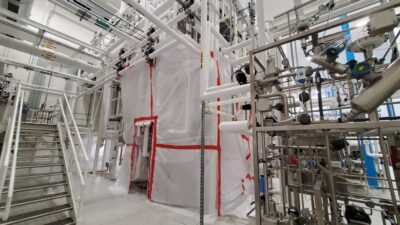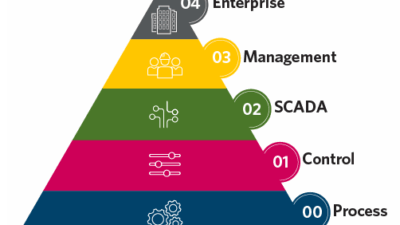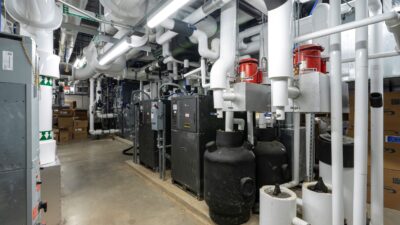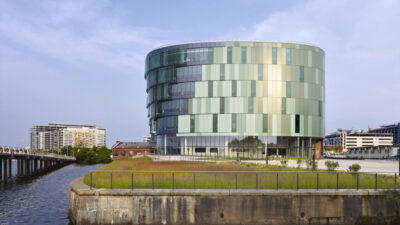Hidden costs may go undetected for years before a qualified TAB professional performs retrocommissioning.
Engineers and owners should be aware of the true cost of poorly balanced buildings, an issue that is prevalent in the competitive plan and specify/test and balance (TAB) market. Hidden energy, O&M, and other costs can go undetected for years until they are discovered in a retrocommissioning project. Without retrocommissioning or a TAB check, the extra costs are never found, and the owner pays high utility costs unnecessarily built into an operating budget.
Most TAB specifications refer to National Environmental Balancing Bureau (NEBB); Associated Air Balance Council ; or Testing, Adjusting, and Balancing Bureau procedural standards. These three associations require an HVAC system’s air and hydronic flows to be adjusted to +/-10% of design flow rates using instrumentation that has been accurately calibrated by a qualified firm using methods and equipment traceable to national standards.
Specifications typically call for the TAB agency to compare the total air flow of an air-handling unit as measured by a pitot reading and compare this flow with the sum of the registers at full flow.
These specifications require both air and hydronic systems to be adjusted to obtain flows with the least amount of static pressure. Procedural standards in all three associations require that at least one open pathway be maintained in each system, each branch within a system, and each terminal box within a branch.
While it is necessary to specify proper TAB procedures, it is even more important to be certain that a certified professional is in charge and responsible for the TAB process. For example, NEBB insists that all certified professionals responsible for TAB projects meet stringent experience requirements, and must pass a very thorough written examination that shows proof of knowledge of the science involved in TAB.
The applicant must then pass a practical examination that shows he/she has the practical skills to actually perform the work. NEBB then insists that both the professional supervisors and firms sign NEBB’s code of ethics form that states the firms pledge to strictly follow procedures.
Measuring up
Failure to follow these simple procedural standards can be costly, and energy costs can be measured and predicted.
A typical 100,000 sq. ft office building may have 110,000 cfm of design air flow requirements and a design motor load of about 110 hp. Energy cost charges for a building that operates 16 h/day, 5 days/week, delivering 55 F air to the occupied spaces, with total electric costs of $0.08 per kWh and gas heating costs at $11 per therm energy can be determined based on changes to the system.
If the HVAC system is set up improperly and delivers 130,000 cfm from the fan to obtain 110,000 cfm in the occupied spaces, the extra motor costs can be calculated from the fan laws:
(130,000 cfm / 110,000 cfm)31.18 x 1.18 x 1.18 x 110 hp = 180 hp(180 hp – 110 hp) x 0.746 kW/hp x 16 h x 260 days/yr = 217,235 kWh/yr217,235 kWh/yr x $0.08 kWh =$17,400/yr or $350,000 over the 20-year life of the building
Failure to leave open paths to diffusers and terminal units results in an increase in total system static pressure. This is a common occurrence on many projects because it is much easier to simply increase the fan static pressure setpoint to achieve the desired air flow than to eliminate the restriction or determine the reason the pressure drop is higher than design.
A 1-in. increase in total system fan static pressure will create the following costs.
The same type of analysis can be used to determine the costs of improperly set up exhaust systems, makeup air, reheating excess supply air, cost of unwanted reheat caused by high pump pressure-induced leaking reheat valves, and myriad other problems seen on many projects. The formulas and equations used to determine various costs can be found in NEBB’s TAB Manual for Technicians and in NEBB’s TAB Training Course for Supervisor’s. These manuals can be purchased online .
This chart shows the cost savings seen in a recent retro-commissioning project. The owner paid these extra costs for 3 years until the building was set up to NEBB standards. During the retrocommissioning process, air flows were lowered to the design requirements, restrictions in the ductwork were removed to reduce the static pressure, hot water leaking past control valves was eliminated by reducing the static pressure output of the heating pumps, occupied time sequences were corrected, and control loops were tuned to operate within a tighter range. The project cost were $100,000, which amounted to a 1.1 year payback.
Issue
Yearly cost savings
20-year cost savings
Excessive fan air flow
$17,400
$350,000
Excessive reheat requirements
$25,000
$500,000
Excessive fan static pressure
$5,500
$110,000
Excessive exhaust makeup air costs
$25,000
$500,000
Excessive pump static pressure
$3,000
$60,000
Leaky reheat valves causing a 3 F air temperature rise
$14,800
$300,000
Total
$90,700
$1,820,000
Lost productivity costs are more difficult to determine. However, the same 100,000 sq. ft office would have 700 occupants based on ASHRAE Standard 62 occupancy requirements. If the average salary and benefit cost per employee is $50,000/yr, the total payroll in the complex would be $35 million/yr.
An improperly balanced building leads to occupant complaints and lost productivity. A 5% productivity loss will cost the building owner $1.75 million in lost wages per year. This productivity loss is 20 times the energy figures.
Specifying engineers need to understand the true cost of improperly balanced buildings. Engineers should specify and owners should select TAB contractors as a professional service provider that is working for the owner and not the mechanical contractor. Building owners cannot afford the increased energy costs caused by the low-bid mentality currently in place. The low initial cost of a low-quality TAB project is too expensive to pay in the long run.



